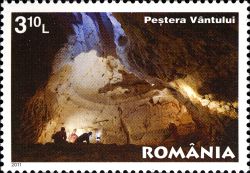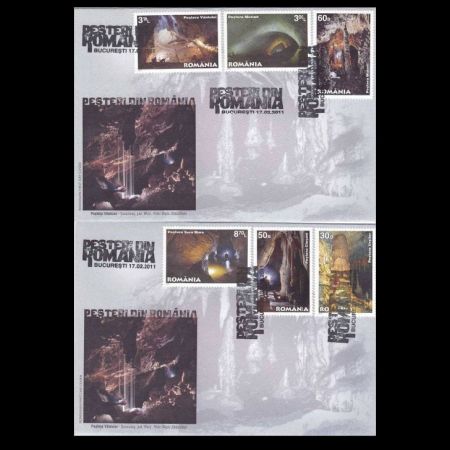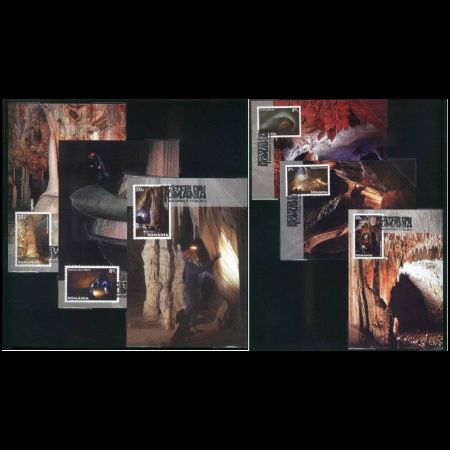Romania
2011
"Romanian Caves"
| Issue Date |
17.02.2011 |
| ID |
Michel: 6493 - 6498 Scott:
Stanley Gibbons: Yvert:
UPU: RO009.11
Category: Ot |
| Author |
Alec Bartos |
| Stamps in set |
6 |
| Value |
0.30 Lei - Ursilor cave
0.50 Lei - Closani cave
0.60 Lei - Muierii cave
3.00 Lei - Meziad cave
3.10 Lei - Vantului cave
8.70 Lei - Sura Mare cave |
| Size (width x height) |
33 mm x 48 mm ; 48 mm x 33 mm |
| Layout |
6 Minisheets of 8 stamps and one tab
(correlated witrh an image of MC.) each |
| Products |
FDC x2
MC x6 MS x6 |
| Paper |
chromo paper
|
| Perforation |
13.5 |
| Print Technique |
Offset, in four colours |
| Printed by |
Fabrica de timbre |
| Quantity |
|
| Issuing Authority |
Compania
Nationala Posta Romana SA |

In the crust of the Earth there are numerous underground holes
naturally formed, some of them of large sizes, called caves.
The appearance of the caves is the result of the erosion caused by the
infiltration of the waters rich in carbon dioxide which dissolved the
soluble rocks, especially limestones. These complex systems of
galleries, vast and high chambers developed on one or several levels
are connected by funnels and pits. In caves, there are often rivers,
cascades and lakes as well as mineral formations such as stalactites,
stalagmites, columns and curtains that are formed after the
precipitation of the calcium carbonate from water. Caves may also
appear on the sea shore due to erosion or in volcanic regions during
the process of lava solidification.
Romania is in a front-ranking place in terms of caves number - more
than 12,000. Romanian caves have been known ever since prehistoric
times, but their study began in the 17th century. We must mention that
Emil Racovita founded in 1920 the world's first Speleological
Institute. In Romania there are several caves which exceed 10 km in
lenght: Vantului (over 50 km), Humpleu (40 km), Topolnita (20 km),
Hodobana (about 20 km), Ciur Ponor-Toplita (17 km), Izvorul Tausoarelor
(16 km), Polovragi (10 km).
The postage stamps issue "Caves from Romania" that Romfilatelia
introduces into circulation illustrates Ursilor, Closani, Muierii, Sura
Mare, Vantului and Meziad caves.
  Ursilor Cave, illustrated on the
postage stamp with the face value of lei 0.30, is situated in Chiscau,
Bihor County, at an altitude of 482 meters and was discovered in 1975.
The name of the cave originates from the numerous cave-bear fossils
discovered here, being anappropriate shelter for animals for more than
15,000 years. They believe that the cave entrance was blocked by a
fallen rock so that more than 140 bears attacked each other because of
hunger. In September 1975, a group of amateur speleologists from
"Speodava" Club explored the cave for the first time and 5 years later
it was opened for tourists. The cave has three galleries: Bones
Gallery, Emil Racovita Gallery, Light Gallery and four chambers:
Candles Chamber, Soda-straw Chamber, Emil Racovita Chamber and Bones
Chamber. Ursilor Cave, illustrated on the
postage stamp with the face value of lei 0.30, is situated in Chiscau,
Bihor County, at an altitude of 482 meters and was discovered in 1975.
The name of the cave originates from the numerous cave-bear fossils
discovered here, being anappropriate shelter for animals for more than
15,000 years. They believe that the cave entrance was blocked by a
fallen rock so that more than 140 bears attacked each other because of
hunger. In September 1975, a group of amateur speleologists from
"Speodava" Club explored the cave for the first time and 5 years later
it was opened for tourists. The cave has three galleries: Bones
Gallery, Emil Racovita Gallery, Light Gallery and four chambers:
Candles Chamber, Soda-straw Chamber, Emil Racovita Chamber and Bones
Chamber.
|
  Closani Cave, illustrated on the
postage stamp with the face value of lei 0.50, is located in Mehedinti
Mountains, at an altitude of 440 m and it is 1,100 m long. It has two
galleries: Laboratories Gallery and Matei Ghica Gallery and it is like
a real natural museum where one may find various types of speleothemes.
Here it is under construction an underground museum of speleology. The
cave shelters more than 70 species of terrestrial and aquatic animals,
as well as protected bat species. Closani Cave, illustrated on the
postage stamp with the face value of lei 0.50, is located in Mehedinti
Mountains, at an altitude of 440 m and it is 1,100 m long. It has two
galleries: Laboratories Gallery and Matei Ghica Gallery and it is like
a real natural museum where one may find various types of speleothemes.
Here it is under construction an underground museum of speleology. The
cave shelters more than 70 species of terrestrial and aquatic animals,
as well as protected bat species.
Muierii Cave (Muierilor Cave),
illustrated on the postage stamp with the face value of lei 0.60, has
been carved in Mesozoic limestones on the Southern edge of Parang
Mountain, in the gorges of the Galbenul River from Oltenia. It has
countless and beautiful formations highly appreciated by tourists such
as Orga Mare, Turcul, Mireasa. The lower galleries of the cave contain
numerous cave-bear fossils and other Quaternary carnivores. Among these
bones they have also discovered the mandible of a Neanderthal man dated
almost 35,000 years ago. Muierii Cave was the first Romanian cave where
they installed the electric lighting in 1957.
|
 |
 |
 |
| Meziad Cave, illustrated on the postage stamp with the
face value of
lei 3.00, is about 5,000 m long. It is located on Meziadului Valley, in
Padurea Craiului Mountains, at an altitude of 300 m. The cave has two
main levels. When they communicate with each other, huge chambers are
formed. Carnivore fossils were found here as well as human dwelling
traces from Paleolithic and Neolithic, attesting that the cave was the
shelter for both humans and animals. The cave is also preferred by bats
for hibernation. |
Vantului Cave, illustrated on the postage stamp with
the face value of
lei 3.10, is situated near Suncuius Commune from Padurea Craiului
Mountains (Bihor County). It was discovered in 1957 and it is the
longest cave in Romania having more than 50 km of galleries. The
underground creek dug in the limestone mountain a maze of narrow and
tall galleries. The Great Meander Racovita is highly representative and
accessible. The cave also contains remarkable plaster and aragonite
formations. |
Sura Mare Cave, illustrated on the postage stamp with
the face value of
lei 8.70, is located on Fruntea Mare Hill, at an altitude of 460 m,
near Ohaba-Ponor Commune. The cave entrance is 45 m high and more than
10 m wide. The length of the cave is about 8,000 meters. It is crossed
by Ohaba River, supplying numerous waterfalls, whirlpools and a lake.
The main gallery with canyon like walls, sometimes exceeds 60 m in
height and in two places even wider, forming huge chambers where
majestic formations may be seen.Sura Mare Cave shelters the largest bat
colony in Europe. |
Products
References:
Romfilatelia
Latest
update 20.01.2018
Any feedback, comments or even complaints
are welcome: [email protected] (you
can email me on ENglish, DEutsch, or RUssian)











